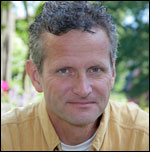Paul Salopek
Nieman Class of 2012
 Salopek is a former Chicago Tribune foreign correspondent and two-time winner of the Pulitzer Prize: for explanatory reporting on the Human Genome Diversity Project (1998), and for international reporting, for his pieces on politics and disease in Africa (2001). He has covered wars in Iraq and Afghanistan, and reported elsewhere in the Middle East and in Central Asia, Latin America and Africa. He has written for National Geographic, The American Scholar, Conservation, and The Atlantic, and, along with the Pulitzer, his stories have won the George Polk Award, the National Press Club Award, the Overseas Press Club Award, the Daniel Pearl Award for Courage in Journalism and the Lovejoy Award, which honors the protection of press freedoms. In 2006, the Sudanese government detained him on spying charges, and held him brutally for a month, after he entered the country illegally from Chad; he was freed from Darfur after a U.S. delegation, which included his editor, Ann Marie Lipinski, who is now the Nieman Foundation curator, appealed for his release. The biggest project of his life began this past January, when he embarked — on foot — from Ethiopia, for the southernmost tip of Chile. The seven-year, 22,000-mile journey, a nonprofit project called Out of Eden, tracks the first human migration from Africa. Salopek’s written dispatches, photos, maps and multimedia renderings ("Welcome to our digital campfire," reads his About page) capture life along the route, and comprise what he calls "slow journalism." He's writing about fishing, camels, pirates, fossils, border patrols, hyenas, salt flats. Salopek spent part of his Nieman year (he was the Foundation’s first Visiting Fellow) preparing for the trip. The Pulitzer Center on Crisis Reporting, the Knight Foundation and National Geographic are also supporting the project. Years from now, once he reaches the Americas, he will hike down the western coastline, "to Tierra del Fuego, the gale-whipped tip of South America where (migrating humans) at last ran out of continents, and where a callow 23-year-old named Charles Darwin began igniting this entire chain of rediscovery in the 1830s." Until then, footfall, stories.
Salopek is a former Chicago Tribune foreign correspondent and two-time winner of the Pulitzer Prize: for explanatory reporting on the Human Genome Diversity Project (1998), and for international reporting, for his pieces on politics and disease in Africa (2001). He has covered wars in Iraq and Afghanistan, and reported elsewhere in the Middle East and in Central Asia, Latin America and Africa. He has written for National Geographic, The American Scholar, Conservation, and The Atlantic, and, along with the Pulitzer, his stories have won the George Polk Award, the National Press Club Award, the Overseas Press Club Award, the Daniel Pearl Award for Courage in Journalism and the Lovejoy Award, which honors the protection of press freedoms. In 2006, the Sudanese government detained him on spying charges, and held him brutally for a month, after he entered the country illegally from Chad; he was freed from Darfur after a U.S. delegation, which included his editor, Ann Marie Lipinski, who is now the Nieman Foundation curator, appealed for his release. The biggest project of his life began this past January, when he embarked — on foot — from Ethiopia, for the southernmost tip of Chile. The seven-year, 22,000-mile journey, a nonprofit project called Out of Eden, tracks the first human migration from Africa. Salopek’s written dispatches, photos, maps and multimedia renderings ("Welcome to our digital campfire," reads his About page) capture life along the route, and comprise what he calls "slow journalism." He's writing about fishing, camels, pirates, fossils, border patrols, hyenas, salt flats. Salopek spent part of his Nieman year (he was the Foundation’s first Visiting Fellow) preparing for the trip. The Pulitzer Center on Crisis Reporting, the Knight Foundation and National Geographic are also supporting the project. Years from now, once he reaches the Americas, he will hike down the western coastline, "to Tierra del Fuego, the gale-whipped tip of South America where (migrating humans) at last ran out of continents, and where a callow 23-year-old named Charles Darwin began igniting this entire chain of rediscovery in the 1830s." Until then, footfall, stories.
Recommended:
—His short, evocative Out of Eden dispatches. Excerpt from “Trail Notes: Water Music,” which includes audio:
And from “Instant City:”
And from “Trail Notes: Tracks:”
—Don’t miss the “Milestone” feature of Out of Eden, in which Salopek records everything from geographical coordinates to elevation to ambient sound. From Milestone 12, Day 157, Mile 1,100:
—Watch Salopek talk about Out of Eden at a spring event at Harvard, and follow him on Twitter via #Edenwalk and @PaulSalopek.
—“Africa: the Ailing Continent,” his 2000 Pulitzer-winning stories out of Africa. Excerpt, from the second installment:
The Featured Fellow series highlights Niemans who have distinguished themselves in narrative journalism and other artful storytelling, and honors the founding of the Nieman Foundation, which turns 75 this month. For more installments, go here.
Nieman Class of 2012
 Salopek is a former Chicago Tribune foreign correspondent and two-time winner of the Pulitzer Prize: for explanatory reporting on the Human Genome Diversity Project (1998), and for international reporting, for his pieces on politics and disease in Africa (2001). He has covered wars in Iraq and Afghanistan, and reported elsewhere in the Middle East and in Central Asia, Latin America and Africa. He has written for National Geographic, The American Scholar, Conservation, and The Atlantic, and, along with the Pulitzer, his stories have won the George Polk Award, the National Press Club Award, the Overseas Press Club Award, the Daniel Pearl Award for Courage in Journalism and the Lovejoy Award, which honors the protection of press freedoms. In 2006, the Sudanese government detained him on spying charges, and held him brutally for a month, after he entered the country illegally from Chad; he was freed from Darfur after a U.S. delegation, which included his editor, Ann Marie Lipinski, who is now the Nieman Foundation curator, appealed for his release. The biggest project of his life began this past January, when he embarked — on foot — from Ethiopia, for the southernmost tip of Chile. The seven-year, 22,000-mile journey, a nonprofit project called Out of Eden, tracks the first human migration from Africa. Salopek’s written dispatches, photos, maps and multimedia renderings ("Welcome to our digital campfire," reads his About page) capture life along the route, and comprise what he calls "slow journalism." He's writing about fishing, camels, pirates, fossils, border patrols, hyenas, salt flats. Salopek spent part of his Nieman year (he was the Foundation’s first Visiting Fellow) preparing for the trip. The Pulitzer Center on Crisis Reporting, the Knight Foundation and National Geographic are also supporting the project. Years from now, once he reaches the Americas, he will hike down the western coastline, "to Tierra del Fuego, the gale-whipped tip of South America where (migrating humans) at last ran out of continents, and where a callow 23-year-old named Charles Darwin began igniting this entire chain of rediscovery in the 1830s." Until then, footfall, stories.
Salopek is a former Chicago Tribune foreign correspondent and two-time winner of the Pulitzer Prize: for explanatory reporting on the Human Genome Diversity Project (1998), and for international reporting, for his pieces on politics and disease in Africa (2001). He has covered wars in Iraq and Afghanistan, and reported elsewhere in the Middle East and in Central Asia, Latin America and Africa. He has written for National Geographic, The American Scholar, Conservation, and The Atlantic, and, along with the Pulitzer, his stories have won the George Polk Award, the National Press Club Award, the Overseas Press Club Award, the Daniel Pearl Award for Courage in Journalism and the Lovejoy Award, which honors the protection of press freedoms. In 2006, the Sudanese government detained him on spying charges, and held him brutally for a month, after he entered the country illegally from Chad; he was freed from Darfur after a U.S. delegation, which included his editor, Ann Marie Lipinski, who is now the Nieman Foundation curator, appealed for his release. The biggest project of his life began this past January, when he embarked — on foot — from Ethiopia, for the southernmost tip of Chile. The seven-year, 22,000-mile journey, a nonprofit project called Out of Eden, tracks the first human migration from Africa. Salopek’s written dispatches, photos, maps and multimedia renderings ("Welcome to our digital campfire," reads his About page) capture life along the route, and comprise what he calls "slow journalism." He's writing about fishing, camels, pirates, fossils, border patrols, hyenas, salt flats. Salopek spent part of his Nieman year (he was the Foundation’s first Visiting Fellow) preparing for the trip. The Pulitzer Center on Crisis Reporting, the Knight Foundation and National Geographic are also supporting the project. Years from now, once he reaches the Americas, he will hike down the western coastline, "to Tierra del Fuego, the gale-whipped tip of South America where (migrating humans) at last ran out of continents, and where a callow 23-year-old named Charles Darwin began igniting this entire chain of rediscovery in the 1830s." Until then, footfall, stories.Recommended:
—His short, evocative Out of Eden dispatches. Excerpt from “Trail Notes: Water Music,” which includes audio:
In the beach town of Thuwal an underemployed Saudi fisherman named Anwar al-Jahdali sang for me. His repertoire was as old as the teakwood dhows that once chalked the Red Sea with their bow-foam. The lyrics told of the forgotten names of winds, of lost love, of pleas to Allah for better fortune. Anwar couldn’t understand where the fish had gone. The government has closed prime fishing grounds and still the hooks come up slack. The fish have “traveled somewhere else” he said. And I thought of my own years aboard trawlers in the Indian Ocean, in the slate North Atlantic, and how we thought ourselves special, elite and free—the last hunter-gatherers in the post-industrial world. We raked Georges Bank into a desert.
And from “Instant City:”
A gas flare burns on the horizon—a second sun. We walk past it. We slog by the silver dome of a roadside mosque. (Its parking lot features a spigot gushing refrigerated, ice-cold water for travelers.) We tug our camels past an oil-stained truck stop. Then, rippling like a hallucination in the distance: an archway of poured concrete. It juts 40 feet or more above the desert flats. It looks like the gateway to a fabled walled city from (the) Arabian Nights. Except there is no city—not yet, at least. And there is no wall. There is only sand dimpled by the six stilt-like legs of darkling beetles. And a hot, embalming wind.
And from “Trail Notes: Tracks:”
Dawn. A sun pale as honeycomb wax. The desert holds us in two dimensions. We walk it. We leave our mark. Our bodies draw their stories.
Awad Omran, the Sudanese cameleer, rocks atop the young bull Seema. He leaves behind him the flat, oval ellipses of camel prints. Glance up: The face of Africa stares back—watchful, skeptical, impassive as the nitrogen-blue sky behind it. Awad says little. He walks rarely. When he does dismount to stretch his bandy legs, he smacks his riding whip rhythmically upon the sand before him. He stencils the desert with chevrons:
/
/
/
/
/
. . . for miles.
—Don’t miss the “Milestone” feature of Out of Eden, in which Salopek records everything from geographical coordinates to elevation to ambient sound. From Milestone 12, Day 157, Mile 1,100:
Somehow we had missed this 100-mile mark — had walked right past it. We had other things on our minds. Banounah was in pain. We were walking him to the hospital in Yanbu. Then we backtracked by car and it seemed an alien world. Not the walked one. The land was out of context. Lonelier. More aggressive, hostile. The hot sandpapery wind. The endless shining plain. The salt sun overhead. It was like a word you could almost, but not quite, remember.
—Watch Salopek talk about Out of Eden at a spring event at Harvard, and follow him on Twitter via #Edenwalk and @PaulSalopek.
—“Africa: the Ailing Continent,” his 2000 Pulitzer-winning stories out of Africa. Excerpt, from the second installment:
One recent afternoon, Shabane, the social worker, toured her home community of Mt. Elias, pointing out houses where people have died. There was the family where both parents had died; a 16-year-old daughter was taking care of her younger siblings. A few blocks away was Granny Lephina's house. She has lost all three of her children to "tuberculosis" and the cost of the funerals--about $450--had bankrupted her.
"Let's stop and see somebody who's dying," Shabane said with an angry smile.
Beauty Ngidi, 22, sat in her brother's home alone, a thin, slow-moving young woman who lived up to her name. The hut was in deep shadow.
"You know, you should admit you have this disease," Shabane said while Ngidi's family hovered warily outside, just beyond earshot.
Ngidi said nothing.
"Beauty, you really should," Shabane repeated softly.
The Featured Fellow series highlights Niemans who have distinguished themselves in narrative journalism and other artful storytelling, and honors the founding of the Nieman Foundation, which turns 75 this month. For more installments, go here.


